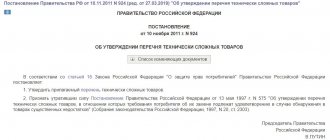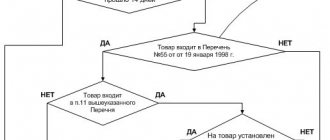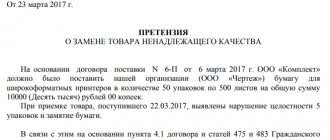Home / Complaints, courts, consumer rights / Consumer rights
Back
Published: 10/06/2018
Reading time: 4 min
5
704
One of the laws of the Russian Federation dated February 7, 1992 No. 2300-1 “On the Protection of Consumer Rights” is dedicated to the protection of the rights and legitimate interests of consumers. This regulatory act provides for a preferential right to protect individuals when purchasing goods and services.
- Implementation of consumer rights when deficiencies are detected
- Concept of significant deficiency
- Consumer rights when significant deficiencies are discovered
- The procedure for determining a significant deficiency
What is a technically complex product?
Technically complex goods (TCT) are durable household items with a complex mechanism. They operate from various energy sources. A technically complex product is supplied with instructions for use, precautionary rules, etc. This is different from conventional products. The list of technically complex goods (TCT) is determined by government regulations and includes:
- Aircraft with an electric motor (internal combustion engine - ICE), helicopters, light aircraft;
- Any vehicles with an electric motor and internal combustion engine for movement on public roads - motorcycles, cars, scooters;
- Any equipment and machines for agriculture with internal combustion engines, electric motors - walk-behind tractors, tractors, motor cultivators;
- Vehicles used to travel on snow are snowmobiles;
- Floating vehicles with internal combustion engines - boats, sports, pleasure, tourist vessels, yachts, boats;
- Wireless communications and navigation equipment (including satellite communications) with 2 or more functions and a touch screen;
- Inkjet and laser MFPs, monitors with digital control unit (control unit);
- Computers, laptops, PCs, system units;
- Game consoles with digital control, satellite television sets;
- Televisions, cinema equipment with digital control unit, digital video and photo cameras, lenses for them;
- Household appliances - freezers, refrigerators, combined freezer-refrigerators, electric stoves and combined gas-electric stoves, coffee machines, ovens (electric and combined gas-electric), dishwashers and automatic washing machines, automatic dryers, electric water heaters, air conditioners, built-in microwave ovens, electric /combined gas-electric hobs, etc.
A significant drawback of a product is a BREAKAGE OF THE PRODUCT THAT DOES NOT ALLOW IT TO BE OPERATED at all, or for a very long period. The law describes the significant deficiency as follows:
- impossibility of repair;
- repeated breakdowns of various functions and parts;
- breakdown of the same function or part again after its elimination;
- the high cost of repairs or their duration.
Classification of product defects
In the existing classification of shortcomings, the legislator distinguishes 2 types:
- simple;
- significant.
Simple deficiencies are those that can be eliminated independently, without the help of specialists.
The second type of flaws is very extensive. These include:
- deficiencies that require significant costs or significant time to eliminate;
- flaws that appear even after attempts to correct them;
- defects that appear repeatedly;
- flaws that cannot be corrected;
- many defects found.
In this regard, a significant defect in a product means defects that make it impossible to use the purchased product normally, as well as those defects that cannot be corrected. Due to this type of defect in things, the consumer cannot fully possess and use his purchase.
The relationship between a patient and his doctor is not always the best. There are times when doctors forget about their duty and do not pay due attention to the patient. Read about independent examination here.
In order to correctly identify a defect identified in a product, as well as to outline ways to solve the problem, you should know that the detected defects have their own classification.
Consumer powers in the event of a significant deficiency
The consumer's rights in the event of a significant defect in a technically complex product differ from the rights in the event of a normal breakdown. If the TCT has an ordinary defect, the owner may have limited claims against the dealer. You cannot demand a refund for TST, exchange for a new product (of the same brand or another with recalculation of the price), markdowns, etc. The owner of the thing has the right to count on repairs or money for its repair. This is presented more clearly in the table:
| Requirements for the seller | TST with a common deficiency | TST with a significant drawback |
| Refund for goods | not presented | presented |
| Exchange for the same product | not presented | presented |
| Exchange for an item of a different brand with recalculation of cost | not presented | presented |
| Cost reduction | not presented | presented |
| Free repair | presented | presented |
| Compensation for repair costs | presented | presented |
However, if the problem is detected before 15 days from the date of purchase, the buyer can make any claim. But after the expiration of the specified period, only the requirements according to the table.
How to determine whether a deficiency is significant?
The consumer does not need to establish many criteria for the materiality of a defect in a technically complex product. It is enough to officially declare a significant shortcoming. It is the merchant’s job to confirm or refute this.
- If the product has repeatedly broken down or the main and expensive component has failed (for example, the motherboard of a laptop, the compressor of an air conditioner, the bean grinding device of a coffee grinder), then the significance of the malfunction is obvious.
- In other cases, it is necessary to focus on personal life experience and basic knowledge. Let’s say the door handle of a refrigerator is broken, a generator of a car, or a computer keyboard is broken, then of course this will be a simple lack of quality of the product.
If you have any doubts, simply contact the seller with the problem and express your desire to control the future fate of the goods. The seller will conduct the inspection himself and report the results.
You may not agree with this test. Then the supplier is obliged to conduct an independent examination at his own expense. During it, as well as when checking the goods, the buyer has the right to be present.
The results of the examination are the most authoritative and competent opinion on the nature of the failure. But even in this case, the owner of the goods may not agree and challenge the conclusion in court.
It is necessary to maintain a balance of interests
Many lawyers believe that the legal regulation of relations between buyer and seller (service provider) must, on the one hand, meet such a criterion as the restoration of consumer rights, and on the other hand, also protect the supplier from excessive burdens. Thus, the return of goods in which a significant defect was discovered must be carried out, as we noted above, on the basis of the principle of proportionality, which is significant in any legal system, including the Russian one.
That is, the buyer’s demand must be satisfied, but only if it is proportionate to the recorded offense. Actually, the role of commodity examination, as many experts believe, is largely related to the need to determine the required balance in terms of proportionality of the buyer’s requirements and violations of the law governing consumer rights committed by the seller or service provider.
Methods for exercising consumer rights
If something breaks, the owner of the item should not hesitate to file a claim. Since, having missed the 15-day period from the date of purchase, the buyer is deprived of ample opportunities to express his claims to the seller/manufacturer. And even if the 15-day deadline is missed, you still shouldn’t hesitate. After all, the period for filing claims is limited by the warranty period for the product. When the warranty period ends, the consumer must prove the cause of the breakdown (this is not easy, plus it is expensive).
Important conversations with the seller should be in writing. The most important thing is to formalize the consumer’s request with a statement in which do not forget to indicate:
- to whom the application is addressed;
- who is the applicant;
- product description;
- what kind of damage was detected;
- information about the warranty period;
- what is the demand being made?
- date of application and date of provision of goods for quality control.
If the seller takes the goods for inspection, it must be sealed in the presence of the consumer. At the same time, the owner of the broken item puts his signature on the seals. This will protect against unauthorized access to the insides of the product. Accordingly, falsifications from a dishonest merchant, such as imitation of a breakdown due to a violation of the rules of operation of the purchase, are excluded. That is, there will be no attempts to shift the blame onto the consumer.
- When transferring goods, you must require the seller to draw up an act of acceptance of the item. The act describes in detail the condition of the goods at the time of transfer.
- If a claim is denied, an explanation of the denial must also be requested in writing.
- If explanations are provided that cannot be agreed with, you should insist on an independent examination (with the right to participate in its conduct).
- The owner has the right to be present at all actions of the expert, ask questions regarding shortcomings, make comments about the progress of the study, and get acquainted with the documents being compiled.
If the expert opinion is negative, the buyer is free to resolve the issue through the court. The claim describes the main events: the purchase of goods, the filing of a claim, the arguments for disagreement with the examination are presented, and demands are made against the seller/manufacturer. At this stage, it is advisable to seek help from a lawyer/attorney. Because you need to know the intricacies of the judicial process, drafting procedural documents and consumer protection legislation.
There is another way to protect your rights. After submitting an application to the seller and receiving a refusal, immediately contact the Consumer Rights Protection Committee. Such an appeal is free, there is a guarantee that your issue will be dealt with by professionals and there is a chance of winning.
Filing a claim
As mentioned above, if a significant defect is discovered, it is necessary to assemble the product in packaging along with all components. The next step is to file a claim. The document is drawn up on standard paper in A4 format.
At the request of the citizen, the paper can be printed or filled out by hand. However, before submitting the document, you must make sure that the warranty period for the product has not expired, since the right of exchange/return is valid only for the duration of the warranty.
The document should include the following information:
- Full name of the outlet to which the paper is supplied. Abbreviations cannot be used; the data must be entered in full. After this, the applicant’s full name, residential address and contact telephone number are indicated. You can specify multiple numbers.
- In the central part of the document, immediately after the header, the word “Claim” is written.
- After the table of contents, the paper describes the circumstances of the purchase of the faulty product. You should indicate what exactly was purchased, in which store, and at what cost. If the purchase was made in the presence of witnesses, it is necessary to indicate them.
- The following describes the citizen's problem. In this case, the purchased product is damaged. It should be indicated exactly when the item broke and what the nature of the breakdown was (if it is possible to establish).
- The requirements part specifies the buyer's requirements for the outlet. What exactly to demand is decided by the buyer himself. A significant breakdown is the basis for the emergence of such a right. In addition, here you can specify requirements for personal presence at the examination concerning the product.
- At the end of the document a date and signature are affixed.
Attention! The document is drawn up in two copies. One remains with the applicant, the other is given to the seller of the outlet. Both documents must be signed by a store representative.
The document must be accompanied by a sales receipt and a warranty card. It is recommended to avoid obscene language, threats, and blackmail. Otherwise, the claim cannot be used in the future, and the seller may legally refuse to accept it.
The claim is submitted to the retail outlet where the product was purchased. You can contact the seller, although it is recommended to visit the store administrator. A written complaint must be submitted upon your first visit to the store.
Such actions will immediately move the proceedings to an official stage regulated by law. You should not rely on verbal agreements with the seller.
After receiving the document, the seller will be obliged to either immediately fulfill the buyer’s requirements or send the product for examination . Further actions directly depend on the expert’s opinion. In case of disagreement with it, the citizen has the right to conduct an independent examination at his own expense, and then initiate legal proceedings.
Read how to correctly write a complaint to Rospotrebnadzor via the Internet and by letter.
Follow the link for information on returning a gift certificate.
Consumer Frequently Asked Questions
Is it possible to conduct an independent examination of the quality of the product before contacting the seller?
Yes, this is not prohibited by law. However, this is not always rational. Firstly, the period for filing a claim begins from the moment you contact the seller, and not the expert. Secondly, the result of the examination is not mandatory for the seller, therefore the procedure for checking the goods and assigning an examination on the part of the seller will be inevitable. Thirdly, sellers do not always take an aggressive position and upon initial contact with the seller, demands can be satisfied voluntarily. Then the costs of the examination remain with the consumer.
Can claims regarding significant defects in complex technical goods be made only to the seller?
No, it is possible to present separate requirements to the manufacturer, service center, and importer. You can demand free repairs from the manufacturer, authorized service center, or importer; compensation for repairs made by a third party or consumer; replacement with the same product or refund of money paid. The requirement can be presented to all specified entities at the same time, but the requirement must be uniform.
If the product is heavy and bulky, how should I make a claim to the seller?
First you need to write a statement of the defect and provide it to the seller. If the goods are oversized or weigh more than 5 kilograms, then the obligation to deliver the goods for inspection and independent examination rests with the seller at his expense and by his own efforts. Upon the fact of transfer of goods, a separate act is drawn up indicating the actual date of transfer. If, at the consumer’s request, the goods are repaired, the goods are also returned to the consumer at the expense of the seller.
Before asking a question to a lawyer, please read the readers’ questions; perhaps a similar case has already been considered and there is a detailed answer, in which case the specialist will not answer you.
Links to legislative acts
- Decree of the Government of the Russian Federation No. 924 of November 10, 2011 “On approval of the list of technically complex goods”
- Paragraph 9 preamble of the Law “On Protection of Consumer Rights” dated 02/07/1992 No. 2300-1 Significant drawback
- Paragraph 8-12 p. 1 tbsp. 18 of the Law “On Protection of Consumer Rights” Consumer rights when deficiencies are discovered
Arbitrage practice
The judicial outcome of the case depends on the buyer’s level of preparedness in collecting evidence and arguments. Any manufacturing defect requires merchandising examination . The judge does not have the technical knowledge to assess the condition of the goods, so he resorts to outside help.
the expert himself to the court hearing , who will cover the technical issues of the breakdown and operate with knowledge.
In most cases, this helps convince the judge that the deficiency is significant.
It is better to draw up a statement of claim with the help of a lawyer . Its form and content are prescribed in Art. 131 of the Code of Civil Procedure of the Russian Federation, and the attached documents are in Art. 132 Code of Civil Procedure of the Russian Federation.
If we analyze judicial statistics, then in such disputes the truth is on the buyer’s side. The task of the injured party is to prove that the breakdown is significant, referring to Federal Law No. 2300-1, Resolution of the Plenum of the Armed Forces of the Russian Federation No. 17, part 4 of MAP Order No. 160, as well as the results of the examination.






